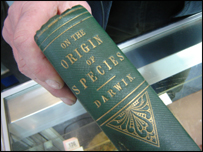 At first sight, the peppered moth (Biston betularia) is an unremarkable creature: a night flying moth which favours temperate climates hiding on twigs and tree trunks during the day.
At first sight, the peppered moth (Biston betularia) is an unremarkable creature: a night flying moth which favours temperate climates hiding on twigs and tree trunks during the day.
Charles Darwin's Origin of Species
Yet this humble insect found itself at the centre of a worldwide debate about the origins of life:
Did we evolve through a process of natural selection, as Charles Darwin proposed? Or is the peppered moth, and therefore all life including Man, the work of a divine Creator?
Evolution
In the early 19th Century, the peppered moth was known to most naturalists, including Charles Darwin, as a predominantly white-winged moth liberally speckled with black.
Then in 1848, as the dark satanic mills covered swathes of northern England in sooty black smoke, a black variant of the moth was discovered in Manchester.
![Mill c. 1830 [courtesy of People's History Museum]](/img/mill_c_1830_courtesy_of_peoples.jpg) 1830: industrial Manchester
1830: industrial Manchester
By 1895, 95% of the Mancunian peppered moths were black. This dark form spread across industrial Britain until the Victorian entomologist JW Tutt suggested that the prevalence of the dark form of the moth was due to it being better camouflaged on dark sooty surfaces than the lighter variant.
Sure enough, following the 1956 Clean Air Act, the black form of the moth began to decline with the return of the white form which was bettered camouflaged on lichen-covered tree bark.
Creationism
To decades of schoolchildren, the adaptation of the peppered moth in response to changes in its environment has been held up as an example of evolution in action.
Not so, however, said critics of Darwin who claimed that the science was not as black and white as it seemed.
"That is why the anti-evolution lobby attacks the peppered moth story. They are frightened that too many people will be able to understand."
Professor Mike MajerusSeizing on a controversy surrounding a scientific study by Bernard Kettlewell on the peppered moth in the 1950s, anti-evolutionists began to question Darwin’s theory on the origin of species itself.






